Product Management – Flashcards
Unlock all answers in this set
Unlock answersquestion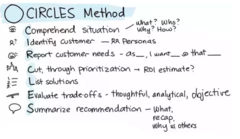
CIRCLES Method (how to approach design problem)

answer
1) Comprehend Situation 2) Identify Customer 3) Report Customer Needs 4) Cut through prioritization 5) List solutions 6) Evaluate trade-offs 7) Summarize Recommendations
question
CTR
answer
Click Thru Rate -1.3 to 3% is target depending on industry -ratio of number of clicks to impressions (Total Clicks on Ad) / (Total Impressions)
question
4 Components to Good Product Strategy
answer
1) Real Pain Points means "Who is it for?" and "What is their pain point?" 2) Design refers to "What key features would you design into the product?" and "How would you describe your brand and voice?" 3) Capabilities tackles the "Why should we be the ones doing it?"and " What is our unique capability?" 4) Logistics is the economics and channels, like "What's our pricing strategy?" and "What's the medium through which we deliver this?"
question
MVP Alternatives -SLC -RAT
answer
SLC - Simple, Lovable, Complete -adds value the way it is, doesn't need a v2 -Snapchat started w/simple photo -simple is good, incomplete is not RAT - Riskiest Assumption Tests -only build enough to test biggest unknown -"Is this the smallest thing we can do test our riskiest assumption?"
question
CSAT
answer
Customer Satisfaction -measures short term happiness (transactional) -does not address how user feels about company as a whole -typically use 1 to 5 scale -# of satisfied customers (4/5) / # of responses "How would you rate your overall satisfaction with the service [or product] you received?" Diff w/NPS -NPS is about long term happiness -NPS measures loyalty
question
Qualities of Great Product Manager
answer
1. Strategic Thinker — Understanding the current needs of the product and how it fits with the company's overall vision. 2. Passion for Products — Love what you make, love what you do. 3. Empathizes with the Customer — and understand the customer's wants and needs. 4. Interviews Customers — Gather insights from your customers, learn their pain points and discover opportunities. 5. Aspires to Build Great Experiences — Understands that user experience is paramount for product success. 6. Keeps Score — Identify the key metrics and track performance, establish baselines to measure success. 7. Ability to Prioritize — Keep things in order, understand what needs to be completed first and what needs to wait. Use customer feedback for prioritization. 8. Collaborative Leader — Management is a collaborative process, you cannot be dictatorial and expect to inspire your team. 9. Execution — Action-oriented, you get things done.
question
Survey Checklist (best practices)
answer
-My survey has a clear objective -My survey has a defined target audience -I know what I want to achieve with my survey -My survey questions are not ambiguous -I know where people will respond to my survey (at home, at work, on the bus...) -I know what I will do with the responses and how to action them -I know how I will distribute my survey (via email, social media...)
question
Survey Best Practices
answer
1) Keep the survey short Max 5 minutes to fill out Include progress bar 2) One question at a time 3) Explain the survey to users in beginning and thank them at the endd 4) Order the questions properly Add sensitive questions at the end
question
Causes for a Bad Product
answer
1) Tunnel Vision 2) Unclear Goals 3) Product Neglect 4) Customer Avoidance - spend at least 3hrs per week 5) Inability to Say "No"
question
Make an App "Sticky" From the Start
answer
1) Let the user try it with no strings attached 2) Keep away from indirect competitors 3) Advertise the possibilities and benefits first 4) Less is more 5) Bridge the gap between the physical and digital worlds
question
Steps for Improving Product Question and Favorite Product
answer
1) Goals 2) Problems 3) Solve Problems 4) Validate Success 1) What problems does it solve? 2) How does it accomplish goals? 3) How does it compare to alternatives? 4) How would you improve it?
question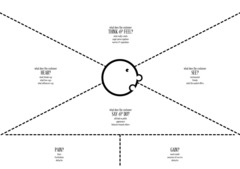
Empathy Map

answer
-A way to understand the user's needs / pains...etc
question
Steps for Designing Product Question
answer
1) Ask questions about problem (clarify) 2) Provide structure 3) Identify users / customers 4) Use cases? Why use product? 5) How well is product w/use cases? 6) What features / changes to improve? 7) Wrap up *Remember to define MVP. Then other features are improvements do ROI
question
Rule of 72
answer
How long until something doubles -increase x% /yr -double after 72 / x yrs e.g. 72 / 8 (compound int rate) = 9 yrs to double
question
Orders of Magnitude
answer
A*B = n digits (A) + digits (B) = digits (A*B) 823 * 1032 has 6 or 7 digits
question
Key Product Metrics (users, conversion...etc)
answer
1) Users / Traffic 2) Conversion 3) Referral Rates / Types 4) Engagement 5) Retention 6) Revenue 7) Costs
question
Key Product Factors (e.g. users / goals...etc)
answer
1) Users and Goals 2) Strengths 3) Challenges 4) Why Why Why 5) Priorities / Values 6) Competitors 7) Trade offs
question
4 P's Framework (marketing plan)
answer
1) Product (establish uniqueness / value) 2) Price 3) Promotion (where to advertise) 4) Place (where to sell)
question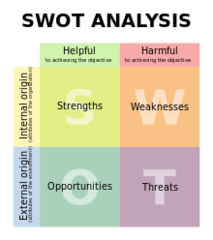
SWOT Analysis (strength / weaknesses and threats)

answer
1) Strengths 2) Weaknesses 3) Opportunities 4) Threats Strengths: characteristics of the business or project that give it an advantage over others Weaknesses: characteristics of the business that place the business or project at a disadvantage relative to others Opportunities: elements in the environment that the business or project could exploit to its advantage Threats: elements in the environment that could cause trouble for the business or project Y-Axis: Internal / External X-Axis: Helpful / Harmful *Strengths / Weaknesses can be about product offering not just organization
question
The 5 C's (product pricing)
answer
1) Company 2) Competitors 3) Customers 4) Collaborators 5) Climate
question
BCG Matrix
answer
Cash Cow -generates more cash than is needed to maintain market share so excess should be reinvested Dogs -are worthless, low market share and low growth - only value in liquidation Question Marks -are high growth, low market share -require far more cash than they can generate -become Dogs when the growth stops -liability Stars -are high market share, high growth -always generates profits -becomes Cash Cow all products become Cows or Dogs -all dependant on obtaining a leader share of market before growth slows Balanced Portfolio has: Stars - high share and high growth assure future Cash Cows - supply funds for growth Question Marks - can be converted to stars w/added funds
question
The 3 C's Marketing
answer
Customer -unmet need?, segment?, price sensitive? Competition -strengths / weaknesses, concentration, potential substitutes Company -strengths / weaknesses, value chain, value add?
question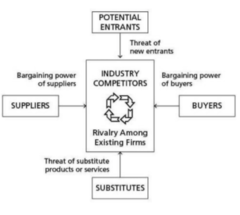
Porter's 5 Forces

answer
1) Rivalry among competitors 2) Buyer Power 3) Supplier Power 4) Threat of Substitutes 5) Threat of New Entrants
question
How to Gather Metrics (specific ways)
answer
1) Usability Testing 2) Customer Feedback 3) Traffic Analysis 4) Logs 5) A/B Testing
question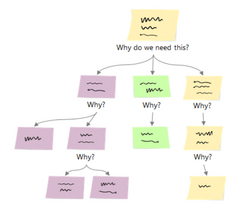
Root Cause Analysis (5 Whys)

answer
1) Ask why problem happens and write down answer below problem 2) Ask why again if it doesn't identify root cause 3) ... repeat E.g. Q: Why did your car stop? A: Because it ran out of gas Q: Why did it run out of gas? A: Because I was lazy ...
question
What does being a PM mean to you?
answer
Leader Define Goal Explain Vision -responsible for guiding the success of a product and leading the team that is responsible for improving it -liaison between stakeholders and implementation teams -PMs are extremely valuable to build the bridge between the outside (market, customers, external stakeholders, partners) and the inside (all the sources around the product)
question
Why Metrics?
answer
1) Maintain focus 2) Set common goal for team 3) Hold everyone accountable 4) Object decision making
question
GAME Framework
answer
-How to establish metrics for a project G -; Goals (user and business) A -; Actions M -; Metrics (use ARM) E -; Evaluations
question
MOSCOW
answer
Must Have Should Have Could Have Would Have
question
Story Points -Why? -Key points
answer
Why? -Avoid scope creep -Establish team velocity -Quickly establish estimates -Eliminate subject hour estimation based on developer skill -Complexity, Effort, Doubt -Not based on hours Base 2 sequence: 0, 1, 2, 4, 8, 16
question
ROI

answer
Return on Investment -Ratio btw business value and complexity
question
Bottom Up vs Top Down
answer
Bottom Up: ideas come from devs / PMs Top Down: ideas come from execs that supply long term vision
question
ARM Framework
answer
-Questions to help establish metrics A -; Acquisition and Activation -what actions do users take to get value and come a customer? R -; Retention and Engagement -what gets my users back to product? M -; Monetization and Revenue -what format of payment does product take?
question
TAM
answer
Total Addressable Market -Quantify market size / opportunity -Bottom Up: figure out how many toothbrushes sold in stores and for what cost -Top Down: market share and total market size
question
ARPU
answer
Average Revenue Per User -figures out value users place on your product -Total Revenue / # Users in Period
question
Cohort Analysis
answer
-how users engage with product over time -shows how much users like your product -"cohort" is a group of users -look at retention of cohorts after 6-12 months
question
Key Usage Metrics (actual metrics to look for)
answer
1) Time on Site 2) Repeat Visits 3) Unique Visitors 4) Active Users 5) Feature Usage
question
Ways to Change Competitive Strategy
answer
1) Diversifying revenue sources 2) Building barriers to entry 3) Being the "One-Stop Shop for ___" 4) Being the Low-Cost Leader 5) Reducing Reliance on a Key Buyer or Supplier 6) Testing a New Market
question
Topics to Discuss for Marketing Strategy (understand A, B, C...)
answer
1) Understand the Company 2) Understand the Competition 3) Understand the Customers 4) Understand the Landscape 5) Market Your Product
question
Topic to Covers for Launch Strategy
answer
1) Target Market 2) User Types 3) MVP or Full Product 4) Distribution 5) Rollout 6) Buzz 7) Partnerships 8) Risks
question
Pricing Strategies
answer
1) Cost Plus Pricing 2) Value Pricing 3) Competitive Pricing 4) Experimental Pricing
question
Pricing Models
answer
1) Free, Ad-Supported 2) Freemium: basic is free but premium costs $$ 3) Tiered 4) A La Carte 5) Subscriptions 6) Free Trial 7) Razor Blade Model
question
Ad Pricing
answer
1) Pay-Per-Click 2) Pay-Per-Impression: sees ad but doesn't have to click 3) Pay-Per-Action: clicks on ad and pays for product
question
Most an Advertiser Would Pay for Ad
answer
-expected profit from click -conversion rate typically 2-5% max for ad = expected profit per click = conversion rate * profit per conversion
question
Common Problems with Products
answer
1) Falling profit 2) Falling revenue 3) Falling sales volume 4) Declining new customers 5) Increase in costs 6) Decline in traffic 7) Decline in new visitors
question
10 Principles of Good Design (and best ones)
answer
**Innovative **Makes a product useful (utility) Aesthetic **Understandable (ease of use) Unobtrusive **Honest Long lasting Thorough / detailed Environmentally friendly As little design as possible
question
1) US population 2) Ave people per household 3) # households in US 4) Life expectancy US 5) Life expectancy World 6) Storage cost per GB
answer
1) 300mm 2) 2.5 3) 100mm 4) 80yrs 5) 65-70yrs 6) AWS is 0.023/gb
question
1) World population 2) European population 3) Asia population 4) Hours in a year 5) Minutes in a year 6) San Fran / NYC population 7) # airports in US 8) # cities in a state
answer
1) 7.2 billion 2) 700mm 3) 4 billion 4) 9000 5) 500,000 6) SF = 850k NYC = 8.3MM 7) 5000 8) 100
question
Market Entry Checklist -Characteristics
answer
-Market Size -Market Growth -Profit Margins -Market Trends
question
Market Entry Checklist -Competitive Environment
answer
-Number of competitors -Competitors resources (human capital, $$) -Competitors unique competences (distribution channels)
question
Market Entry Checklist -Company Fit
answer
-Expertise -Economies of scale -Access to distribution channels -Good relationships with suppliers -Related to existing brand promise
question
1) US GDP 2) US GDP Growth Rate 3) US Corporate Tax Rate 4) US Smartphone Penetration 5) US % Under 18 6) US % Over 65
answer
1) 17 trillion 2) 2% 3) 35% 4) 70% 5) 23% 6) 13%
question
Market Size Question Solving Steps
answer
# of people in population * % target customers * purchase frequency * quantity purchased * price per unit
question
Revenue Estimation Question Solving Steps
answer
1) Estimate revenue for a single store / product 2) Estimate total # of store (total units) 3) Multiple 1 and 2 for revenue
question
Lifetime Value Question Solving Steps
answer
= Ave contribution per sale * Sales per year * # of years per customer
question
TCP/IP Data Flow
answer
Computer -> Application Layer (HTTP) -> Transport Layer (TCP) -> Network Layer (IP) -> Data Link Layer Ethernet
question
Questions to Ask a Company
answer
-How do all of the products fit together? -Who are the competitors? How does the company differentiate? -What is the revenue model? -What do customers love / hate about product? -What are the key metrics? How many users... conversion rate... growth rate? -What are your product weaknesses? -What are the product's competitive advantages? -What threats are there impending? -
question
Questions to Ask About Role
answer
**What are top 3 qualities looking for in a candidate -How technical is the role? -How much time on writing requirements... managing timelines... building roadmap... etc -Where do ideas come from? Bottom-up or Top-down? -Manage innovation? Is product relatively change averse or willing to take informed risks? -How do you make design decisions? Surveys... studies... A/B testing? -What is most challenging about being a PM here?
question
Agile Key Tenants -Advantages / Disadvantages
answer
-Respond to change quickly -Iterative and Incremental -Communication, transparency, constant feedback Advantage: respond and deliver quickly Disadvantages: hard to scale, difficult to create roadmap
question
INVEST -story best practices
answer
Independent Negotiable Valuable Estimable Small Testable
question
SCRUM -Scrum Master duties -Product Owner duties
answer
Scrum Master -establishes scrum practices / rules -ensures team is fully functional -sets up meetings -help with the backlog Product Owner -defines features of product; focus on ROI -track value and return -scope management / prioritize backlog -accept or reject work
question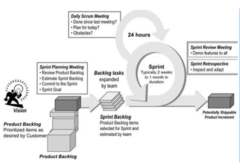
Key SCRUM Meetings

answer
-Daily Scrum -what'd you do yesterday? -what will you do today? -any blockers? -Sprint Review -1/2 day; demo work to stakeholders -acknowledge achievement -Sprint Retrospective -Sprint Planning -1/2 day; 60% must haves -Backlog Refinement
question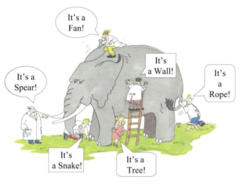
Agile, Lose Big Picture Focus -Why? -How to fix

answer
Why -lack of clear roadmap from PM -myopic view of team (only focused on one section of product) Fix -Story mapping
question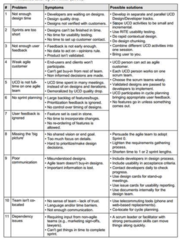
Agile Issues

answer
-Not enough design time -Sprints are too short -Not enough user feedback -No sprint planning -Lacking big picture -Poor communication -Dependency issues
question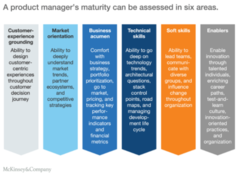
What Makes a Good PM?

answer
-Ownership of product -Convincing and persuasive (lead / influence) -Be optimistic and positive -Get technical -Celebrate others -Be fearless when discussing ideas
question
Common PM Duties
answer
-Analyze log files for data trends -Prioritization of backlog -Launch preparation -Post launch analysis -Create mock-ups
question
Types of Metrics
answer
Qualitative: usability testing Quantitative: traffic analysis Comparative: A/B testing Competitive: monitor competitors
question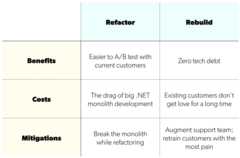
Decision Matrix

answer
-Benefits / Cost / Mitigations -Option A / B
question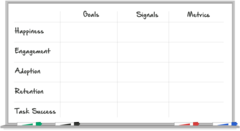
Heart Framework -and Goals Signals Metrics

answer
-Categories used to help define metrics -Try to have a few metrics in each category Happiness: measure of user attitude (via survey)... net promoter score, satisfaction Engagement: level of user involvement (# of visits per week) Adoption: new users of product / feature Retention: rates at which users are returning (churn) Task Success: behavioral metrics such as efficiency, effectiveness and error rate
question
Customer Oriented Metrics
answer
-Product usage or adoption -Percentage of prospects who take an action in response to campaign -Percentage of users who take action in product -Customer retention or churn rate -Quality (# of bugs)
question
Business Oriented Metrics
answer
-Cost to acquire a new customer (CAC) -Customer lifetime value (LTV) -Monthly recurring revenue generated (MRR) -Average revenue per user Conversion
question
Cohort Metrics
answer
-Number of sessions per user (cohort of users), over time -Session duration for a cohort, over time. -Number of user actions per session, for cohort, over time. -Action completion rate & differences between different cohorts
question
KPIs
answer
-Key Performance Indicator -Do not answer why -Measure performance, monitor progress, data for decision making -KPIs are derived from the product vision and tell you how well your product is meeting the vision Examples -Deviation of set hours of work -Planned budget deviation -Missed milestones -Cost variance metrics
question
SCAMPER (brainstorming)
answer
Substitute -What part can be substituted without affecting whole? Combine -How to merge two idea in innovative way (e.g. phone tech and camera) Adapt -How to tweak and adjust for better output Modify -Change to release more innovative capabilities Eliminate -Remove a part of process / product to improve it Reverse
question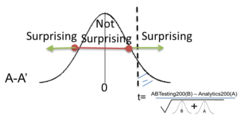
P-Value

answer
-used to determine statistical significance of scientific test -A/B testing validation -reflects risk tolerance and confidence in test -X < 0.05 -larger sample size the more confident in result -does not always mean its an accurate assumption
question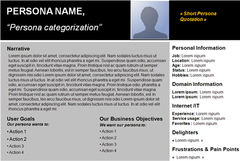
Persona -what to include -what makes a good one?

answer
Behaviors -degree of loyalty / usage Demographics -age, gender, income, education -country, climate, population Needs & Goals Include on Card... -Name / Title -Goals -Attributes (demographics) -Needs / Challenges -Skills / Behaviors Good Personas are... -reflect patterns from Research -focus on current state -are realistic -help understand users
question
Personas -Why?
answer
-Develop a deeper understanding of customer needs and how to solve for them -Guide product development by creating features that help them achieve their desired outcomes -Prioritize which projects, campaigns, and initiatives to invest time and resources on -Create alignment across the organization and rally other teams around a customer-centric vision
question
How to Build Trust w/Stakeholders?
answer
1) Be willing to learn and let others know 2) Understand the industry and tech 3) Use metrics / stats to reduce subjectivity 4) Communicate and be transparent...keep stakeholders up-to-date
question
Estimate Question Math -Volume of Sphere
answer
Volume of Sphere -4/3(pie)(r^3)
question
Financial Terms -Fixed Cost (examples) -Variable Cost (examples) -Gross Profit -Market Penetration -Operating Margin
answer
Fixed Cost -Insurance -Rent -Utilities -Advertising Variable Cost -Materials / Labor -Shipping Gross Profit = Revenue - Cost of Goods Sold -In accounting, gross profit, gross margin, sales profit, or credit sales is the difference between revenue and the cost of making a product or providing a service, before deducting overheads, payroll, taxation, and interest payments Market Penetration = Customer / Potential Customers Operating Margin = Operating Income / Total Revenue
question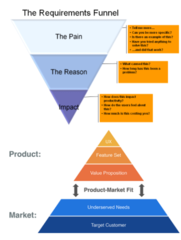
Funnel -Uber example

answer
-start broad then narrrow -broad inputs that narrow down into final product or output -develop, measure and optimize -a funnel is made up of the measurement of the key event at each step of the flow or user journey -By putting these measurements together you can see where the leakage is in the funnel. The leakage is where people stop completing the task they set out to do 1. Discover the pain points 2. Find the reason for the problem 3. What is the impact of the problem Uber's 2 Funnels 1) on boarding 2) booking transportation
question
Steps to Plan Analytics Implementation
answer
1) Define the product vision 2) Define the KPIs that meet the product vision 3) Define the metrics that allow you to hit your KPIs 4) Define the funnels (via user journeys) that affect your metrics
question
Segmentation

answer
1) Geographic 2) Demographic 3) Psychographic 4) Behavioral
question
Managing Change -Kotter's 8 Steps
answer
1) Establish sense of urgency 2) Create guiding coalition 3) Develop a vision and strategy 4) Communication change vision 5) Empower broad-based action 6) Generate short-term wins 7) Consolidate gains and produce more change 8) Anchor new approaches in culture
question
Change -conflict -time -communication
answer
-Conflict is inevitable with change. How you respond determines your reactions -Success with change takes time to obtain, it is not a straight line path. -Communication should be a priority for every manager at every level of the firm -When you are so sick of talking about something that you can hardly stand it, your message is finally starting to get through
question
Core User Properties
answer
Top of Mind: come directly, not because of reminder or google search...etc Recurring: do they come back again and again? Referring: do they share with others?
question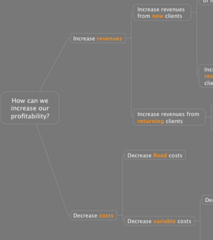
Issue Trees -e.g. How can we increase our profitability?

answer
-Use in Why Why Why -Start with high level question and break down via a tree
question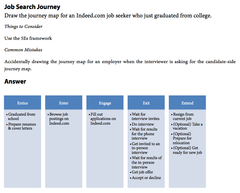
User Journeys

answer
-Break down into stages of interacting with the product -For each stage, write down the key actions Good User Journeys help to... 1) Empathize with the customer 2) Discover product improvement opportunities
question
5E's Framework
answer
-Entice. What event triggers a user to enter into the UX funnel? -Enter. What are the first few steps in the UX funnel? -Engage. What task(s) is the user trying to accomplish? -Exit. How does the user complete the task? -Extend. What follow-up actions occur after the user completes the task?
question
A/B Testing -names -best practices
answer
-A.k.a split testing or bucket testing -Version A (control) vs Version B (challenger) to see which has higher conversion rate -"cooked" term for when test is complete -Lift = increase Best Practices -Test should run until at least 95% chance to beat control -Test for a minimum of 7 days (takes into account weekdays and weekends -Do not focus on just one metric. Make inventory of important metrics before and after every test you run -Create segments and run A/B tests on them separately to gauge big picture
question
Multi-Variate Testing
answer
-Multivariate involves testing multiple differences. Instead of 2 versions of a page, create N variations with different version of elements on each page -Can show that a footer has no effect on conversion -Really good for redesign efforts -Requires a lot of traffic / data to run variations
question
Net Promoter Score
answer
-How likely are you, on a scale of 0 (not at all likely) to 10 (extremely likely), to recommend this product or service to a colleague or friend? -A company's Net Promoter Score is the percentage of promoters less the percentage of detractors -"Detractors" answer from 0 to 6 -"passives" answer 7 or 8 -"promoters" answer 9 or 10
question
Common Issues Facing PMs
answer
-No direct authority; have to convince -No measurement -Rapid shuffling of teams / projects -Success theater -Infrequent acknowledge failures -No connection to core metrics -No PM retrospectives -No tweaking / iteration -Shiny objects
question
Types of Roadmaps
answer
-Gantt -Scrum Sprints -Story Map
question
KPI -holy trinity
answer
1. Retention 2. Growth 3. Montization



